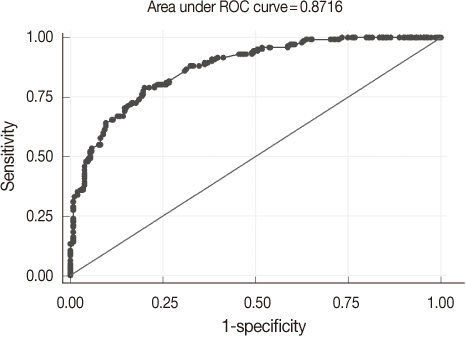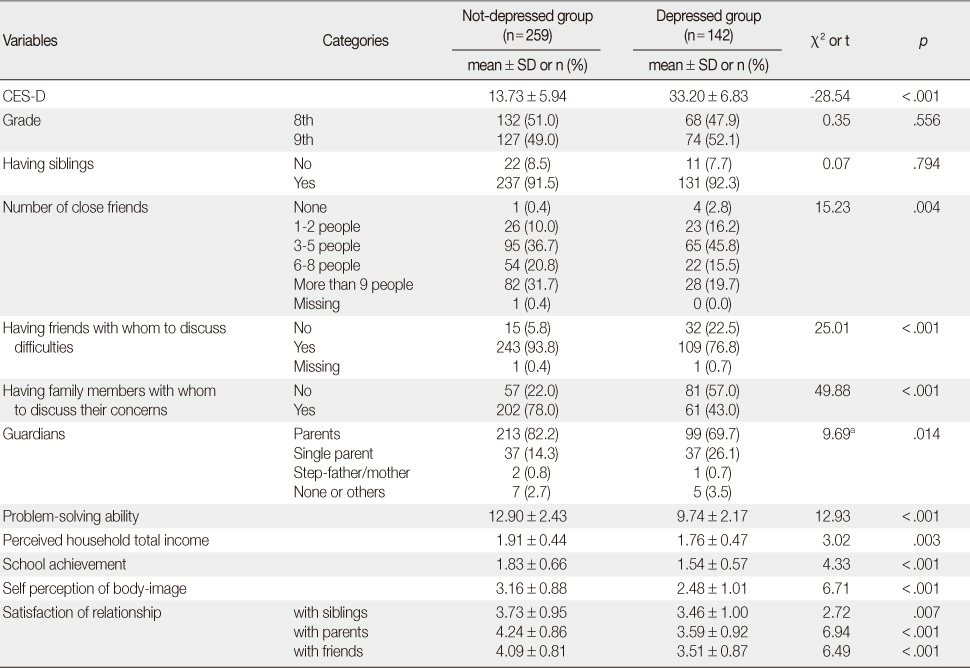Articles
- Page Path
- HOME > J Korean Acad Nurs > Volume 41(4); 2011 > Article
-
Original Article
- Factors Influencing Depression among Middle-School Girls
- Haejung Lee, Hee Young Jung, Eunyoung Yun, Hwa-Yun Um, Young-Ju Jee
-
Journal of Korean Academy of Nursing 2011;41(4):550-557.
DOI: https://doi.org/10.4040/jkan.2011.41.4.550
Published online: August 31, 2011
1Professor, College of Nursing, Pusan National University, Busan, Korea.
2Doctoral Student, College of Nursing, Pusan National University, Busan, Korea.
3General Manager, Department of Biostatistics Clinical Trial Center, Pusan National Universtiy Hospital, Busan, Korea.
4School Nurse, Sajik High School, Busan, Korea.
5Doctoral Student, College of Nursing, Pusan National University, Busan, Korea.
- Address reprint requests to: Lee, Haejung. College of Nursing, Pusan National University, Beomeo-ri, Mulgeum-eup, Yangsan 626-770, Korea. Tel: +82-51-510-8344, Fax: +82-51-510-8308, haejung@pusan.ac.kr
© 2011 Korean Society of Nursing Science
Abstract
-
Purpose
- The purpose of this study was to investigate the prevalence of depression among school girls in Korea and identify factors influencing the tendency to depression.
-
Methods
- A self-report survey was conducted with South Korean middle schoolgirls who were in the 8th and 9th grades. Four hundred and one schoolgirls were included in the study. The instruments utilized in this study were the Center for Epidemiologic Studies - Depression Scale and Social Problem Solving Inventory-Revised. Data were analyzed using descriptive statistics, Pearson correlation and multiple logistic regression with SPSS WIN 14.0 program.
-
Results
- The average depression score of the participants was 20.68, which indicates moderate levels of depression. About 35% of the schoolgirls in this study reported a tendency to depression. Significant predictors for depression were 'decreased problem-solving abilities', 'no family members with whom they can discuss their concern', 'decreased satisfaction in relationship with friends', and 'increased negative self-perception of body-image'.
-
Conclusion
- The study findings suggest that schoolgirls require special concern regarding the risk of developing depression. Regular depression screening could be beneficial for early detection of depression in schoolgirls and enhancing problem-solving ability could be considered as an effective strategy to reduce the risk of depression among schoolgirls.
- 1. Bang MY, Kim BH. Analysis of variables influencing depressive emotions of adolescents. Journal of Play Therapy. 2010;14(1):105–119.
- 2. Becker-Weidman EG, Jacobs RH, Reinecke MA, Silva SG, March JS. Social problem-solving among adolescents treated for depression. Behaviour Research and Therapy. 2010;48:11–18. doi: 10.1016/j.brat.2009.08.006.ArticlePubMed
- 3. Cho HJ, Yim HW, Jo SJ, Bang MH. Gender differences in depressive symptoms and reluctance to seek help. Korean Journal of Woman Psychology. 2008;13:283–297.Article
- 4. Choi Y. A study on tendency and related factors of depression experienced by middle school students in Seoul. 2007;Seoul, Hanyang University. Unpublished master's thesis.
- 5. Choi YS. A study of the reliability and validity of the social problem solving inventory-revised (SPSI-R). Korean Journal of Clinical Psychology. 2002;21:413–428.
- 6. D'Zurilla T, Chang E, Nottingham E, Faccini L. Social problem-solving deficits and hopelessness, depression, and suicidal risk in college students and psychiatric inpatients. Journal of Clinical Psychology. 1998;54:1091–1107. doi: 10.1002/(SICI)1097-4679(199812)54:8<1091::AID-JCLP9>3.0.CO;2-J.ArticlePubMed
- 7. D'Zurilla T, Nezu A. Problem-solving therapy: A social competence approach to clinical intervention. 1999;2nd ed. New York, Springer.
- 8. Garber J. Depression in children and adolescents: Linking risk research and prevention. American Journal of Preventive Medicine. 2006;31:6S1. S104–S125. doi: 10.1016/j.amepre.2006.07.007.PubMed
- 9. Ha EH, Oh KJ, Song HD. Psychosocial risk factors for comorbid adolescents with depression and anxiety. Korean Journal of Psychology: General. 2003;22:127–144.
- 10. Hosmer DW, Lemeshow S. Hosmer DW, Lemeshow S. Assessing the fit of the model. In: Applied logistic regression. 2000;2nd ed. New York, Wiley. 143–202.Article
- 11. Kim HW. The relations among adolescents' depression, problem solving ability, self efficacy and stressful life event. 2006;Seoul, Yonsei University. Unpublished master's thesis.
- 12. Kim SK. The effects of self-esteem and self-control on social problem-solving. 2009;Daegu, Catholic University of Daegu. Unpublished master's thesis.
- 13. Lee HJ, Kim KR, Seo JM. Effects of telephone counseling on burnout, depression, life satisfaction, and perceived health in caregivers of older adults with dementia. Journal of Korean Academy of Adult Nursing. 2003;15:452–462.
- 14. Lee JS, Myung SY. A study on adolescents' anti-depressive coping behaviors according to their depression level. Korean Journal of Youth Studies. 2008;15:39–63.
- 15. Lee SH, Hyun MH. The effects of obesity, body image satisfaction, and binge eating. Korean Journal of Health Psychology. 2001;6:195–207.
- 16. Lewinsohn PM, Rohde P, Seeley JR, Klein DN, Gotlib IH. Natural course of adolescent major depressive disorder in a community sample: Predictors of recurrence in young adults. The American Journal of Psychiatry. 2000;157:1584–1591.ArticlePubMed
- 17. Maydeu-Olivares A, D'Zurilla TJ. A factor-analytic study of the social problem-solving inventory: An integration of theory and data. Cognitive Therapy and Research. 1996;20:115–133.ArticlePDF
- 18. McCarty CA, Violette HD, McCauley E. Feasibility of the positive thoughts and actions prevention program for middle schoolers at risk for depression. Depression Research and Treatment. 2011;Retrieved November 24, 2010. Article ID 241386, 9 pages, from http://www.hindawi.com/journals/drt/2011/241386.html doi: 10.1155/2011/241386.
- 19. Child and adolescent ADHD, depression etc. screening and treatment support. Ministry of Health & Welfare. 2009;04 08 Retrieved October 15, 2010. from http://mw.go.kr/front/al/sal0301vw.jsp?PAR_MENU_ID=04&MENU_ID=0403&page=1&BOARD_ID=140&BOARD_FLAG=&CONT_SEQ=211314&SEARCHKEY=CREATE_DATE&SEARCHVALUE=&CREATE_DATE1=2009-04-08&CREATE_DATE2=2009-04-08.
- 20. Oh HA, Park YR, Choi MH. The effects of parent-adolescent communication and depression on suicide ideation. Korean Journal of Child Health Nursing. 2008;14:35–43.
- 21. Park BK, No PS. Factors associated with adolescents' suicidal ideation: Comparative study of depression group and non-depression group. Mental Health & Social Work. 2007;26:168–193.
- 22. Radloff LS. The CES-D Scale: A self-report depression scale for research in the general population. Applied Psychological Measurement. 1977;1:385–401. doi: 10.1177/014662167700100306.ArticlePDF
- 23. Sadowski C, Moore LA, Kelley ML. Psychometric properties of the social problem-solving inventory (SPSI) with normal and emotionally disturbed adolescents. Journal of Abnormal Child Psychology. 1994;22:487–500.ArticlePubMedPDF
- 24. Shin SC, Kim MK, Yun KS, Kim JH, Lee MS, Moon SJ, et al. The Center for Epidemiologic Studies-Depression Scale (CES-D): Its use in Korea-standardization and factor structure of CES-D. Journal of Korean Neuropsychiatric Association. 1991;30:752–767.
- 25. So SS, Song MK, Kim CS. The effects of perceived parenting behavior and school adjustment on the depression of early adolescent. Korean Journal of Youth Studies. 2010;17(3):1–23.
- 26. Sohn BD. Multi-variate predictors on the depressed mood and suicidal risk among ordinary adolescents and adolescents with learning disabilities. Korean Journal of Youth Studies. 2005;12(1):207–228.
- 27. Tabachnick BG, Fidell LS. Using multivariate statistics. 2001;4th ed. Boston, Allyn & Bacon.
- 28. Um HY, Lee H, Jee Y. Predictors of depression in middle-school girls. Journal of Korean Academy of Fundamentals of Nursing. 2010;17:470–477.
- 29. Yi MJ, Ahn CY. Social problem solving ability and attitude of depressive persons. Korean Journal of Clinical Psychology. 1997;16:85–100.
REFERENCES
Figure & Data
REFERENCES
Citations

- Differences in Factors Associated with Depressive Symptoms between Urban and Rural Female Adolescents in Korea
Gyuyoung Lee, Ok Kyung Ham, Bo Gyeong Lee, Abuan Micah Kim
Journal of Korean Academy of Nursing.2018; 48(4): 475. CrossRef

Figure 1
Comparison of Characteristics between Non-depressed and Depressed Groups (N=401)
Fisher's exact test.
Multiple Logistic Regression - Predictors of Depression in Middle School Girls (N=401)
Nagelkerke R2=.51; χ2=184.08; df=4; p<.001; Hit ratio=80.5%; Each variable adjusted for all other variables in the table; SE=Standardized Error; OR=Odds ratio; CI=Confidence interval.
Fisher's exact test.
Nagelkerke R2=.51; χ2=184.08; df=4;
 KSNS
KSNS
 E-SUBMISSION
E-SUBMISSION



 Cite
Cite

